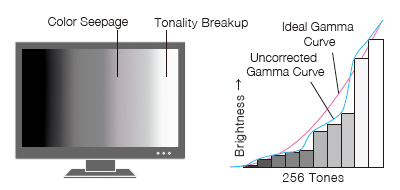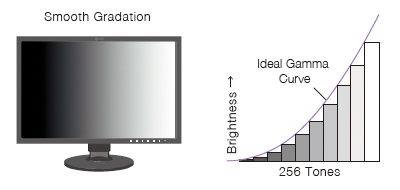Color Management Resources
Hardware vs Software Calibration
The Importance of Keeping Your Screen Accurate
Every creator needs to be able to trust that what they see on their screen is an accurate reflection of how their work will look in the end – whether it is in print, online, or viewed on another display device. The correct color fidelity, gradations, color temperature, brightness, and tone stability are characteristics that determine the accuracy of your screen. Choosing a monitor that can properly calibrate and maintain those characteristics is critical in the digital creative workflow. Calibration is the method by which a monitor’s display characteristics are adjusted to a specified target value using a dedicated sensor, or colorimeter. There are two methods: hardware calibration and software calibration.
Software Calibration
In the software calibration process, the monitor’s characteristics are measured by the calibration sensor and the results are used to create an ICC profile that the computer uses to map the color output via the graphics board. Almost any monitor can use this method, making it widely accessible, but labor-intensive and impractical for color-critical work. Software calibration usually requires a great deal of manual adjustment and the results may vary depending on the graphics board and other factors. The calibration will also not “stick” to the monitor if the computer is rebooted. Furthermore, there is high risk for losing color information through software calibration. For example, let’s consider a monitor that has 255 steps of red (R), green (G), and blue (B), with the color temperature set to 6500K. If you lower the color temperature to 5000K, the G and B will also lower, meaning you end up with less than the original 255 gradation steps for G and B. This extends to the number of steps in gamma and brightness as well, together resulting in your images displaying with more deviating color and banding due to skipped gradations.

Hardware Calibration
Hardware calibration is a process in which display characteristics are adjusted inside the monitor itself. EIZO’s ColorEdge color management monitors utilize hardware calibration and setting a target in its dedicated color management software, ColorNavigator. The ICC profile is automatically generated when the calibration completes, and the calibration information is saved directly to the monitor instead of the computer’s operating system. So even if you reboot or change to a different computer, with ColorNavigator the monitor stays calibrated. Only the output of the monitor is adjusted to achieve a chance in white point, brightness, and tone, without reducing the maximum number of gradation steps that are available to select from. For example, if the monitor has 255 steps of R, B, and G, and you lower the color temperature, the number of gradation steps inside the monitor does not change, rather it adjusts by selecting the most appropriate tones from its own LUT (look-up-table) to display color. This results in smoother gradations without missing steps.





